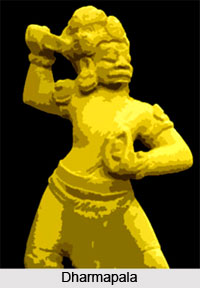Dharmapala`s reign was marked by the struggle between Pala, Rashtrakuta and Pratihara over the supremacy of Northern and Eastern India. Major ruling dynasties took advantage of absence of any paramount ruler in North India. This created a tripartite struggle between Pratiharas of Rajputana and Malwa, Palas of Bengal and Rashtrakutas of Deccan. The northern antagonist of Dharmapala was Vatsaraja Pratihara of Rajputana and Malwa. While Dharmapala was pushing back the boundary of his kingdoms to the extreme west, Vatsaraja was expanding his kingdom in the east, with the aim to occupy the city of Kannauj. Dharmapala probably had conquered Magadha and had extended his sway possibly beyond Allahabad.
 Battles of Dharmapala
Battles of Dharmapala
The first phase of the struggle opened up with the battle between Dharmapala and Vatsaraja, in the region of Doab, where Dharmapala was defeated. In due course Rashtrakuta king Dhruva appeared in the scenario and crushed Vatsaraja to defeat. Dharmapala was the next target of Dhruva`s northern campaign. He marched towards Doab and wreaked a devastating defeat upon Dharmapala. He was however unable to But annex his northern campaign. Later when he retired for Deccan, Dharmapala resumed his struggle with the Pratiharas for the mastery over north India.
A temporary vacuum was created in the political scenario of North India when Dhruva returned to Deccan and Vatsaraja was shattered by the Rashtrakutas earlier. Dharmapala quickly built steps towards his own ascendancy due to the temporary obscurity of his rivals. The Khalimpur Copper Plate of Dharmapala and the Bhagalpur Copper Plate of Narayana Pala provide facts about the Northern conquest of Dharmapala. From Bhagalpur Copper plate it is known Dharmapala had conquered Kanauj and had deposed the king of Kanauj, Indra Raja. He stationed his own nominee, Chakrayudh on the throne of Kanauj. Dharmapala made Chakrayudh his own vassal and himself assumed the sovereignty of Kanauj. Dharmapala had also occupied the regions of Kedara, Gokarna and most of the Himalayan regions. Dharmapala had also held a Durbar at Kanauj. The kings of Bhoja, Matsya, Madra, Kuru, Yadu, Yavana, Avanti, Gandhara and Kira had attended it and also had offered their submission to Dharmapala as their suzerain.
Conquests of Dharmapala
Dharmapala had extended the sway of his territory to a larger extent through all these conquests. Though Dharmapala had conquered almost a major part of North India, yet he did not rule the whole Empire individually. He had entrusted vassals to rule on his behalf with a degree of autonomy. Subordinate chiefs of Dharmapala had ruled a long stretch of the territory, between the borders of Bihar and Punjab. A considerable number of kingdoms in Punjab, Eastern Rajputana, Malwa, Berar served as the vassal states of Dharmapala. The actual extent of Dharmapala`s Empire stretched from Bengal in the east to the farthest limit of the northwest and perhaps even beyond the Himalayas in north. Towards the south his Empire included the regions of Malwa and Berar. Due to his huge conquest in the North, Dharmapala was titled with the epithet "Uttarapatha Swamin".
However this fame and prosperity was transitory. The fresh and renewed attack of the Pratiharas appeared as a challenge to the undisturbed sovereignty of Dharmapala. Nagabhatta II opened the second round of tripartite struggle, by attacking Kannauj and defeating the subordinate chief of Dharmapala, Chakrayudh there. This event raised fresh conflict between Pratihara king Nagabhatta II and Pala king Dharmapala. As a result a battle took place between these two powers, probably in the region of Monghyr, where Dharmapala was defeated. In due course the Tibetan invasion also took place against the authority of Dharmapala in north India. Before Nagabhatta could completely crush the power of his eastern adversary, the Rashtrakutas from south had cut short the victorious career of Nagabhatta II. Finally the Rashtrakuta king, Govinda III, defeated the Pratiharas and Pala supremacy. Rashtrakutas retired to their original homeland in Deccan, after which Dharmapala again revived his power.
The reign of Dharmapala constituted a glorious epoch in the history of ancient India. By his prowess and diplomacy he expanded a small kingdom concentrated in Bengal to a vast Empire, covering large portions of North India. Though he could not accomplish any violent conquests against the Pratiharas or the Rashtrakutas, yet his chief achievement lies in his diplomatic steps he had adopted in the task of extending the Pala kingdom. However Dharmapala was a mighty conqueror. He brought major parts of northern India under the dominion of the Pala authority by his enormous take-overs. Dharmapala`s reign had a special significance in Bengal, because after the death of Sasanka, when forces of disintegration had set within the heart of Bengal, giving rise to socio-political anarchy, it was Dharmapala who had restored the province from being completely shattered and disintegrated. Under him Bengal enjoyed imperial status, which was unparalleled.
Dharmapala as Patron of Art
Dharmapala had made his mark in the ancient history of India not only as a mighty conqueror, but also as a great patron of art, architecture, and literature. Simultaneously he was a great patron of Buddhism and worked for the encouragement of Buddhism as his state religion. He had established the great Vikrammsila Vihara in Magadha and probably also the celebrated monastery of Odantapuri. He had also constructed the celebrated Somapura Vihara. Apart from being a patron of Buddhism, he also patronised Education. A galaxy of scholars had flourished during his time. Haribhadra was one such scholar.
Though Dharmapala was a Buddhist king, he was tolerant towards other religious creeds also. Brahmanical Hinduism was also a prevailing religious creed in Bengal. He was equally a patronage of the Brahmanical shrines. He initiated a policy of religious toleration and mutual co-existence of different religions, which was one of the glorious legacies of Pala rule in Bengal. Dharmapala was also a shrewd diplomat and a good statesman. The efficient statesmanship of Dharmapala is evident from the thriving prosperity, which Bengal had attained during his reign.



















